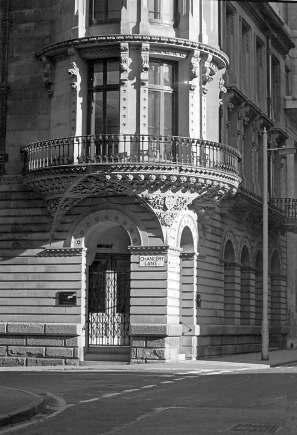Brooks's Bank (Lombard Chambers) 46-48 Brown Street, Manchester
In 1868, new offices were built at the rear of Brooks’s Bank. The style chosen was basically classical with Gothic decoration. The Builder commented "the style is really showing in successful combination some of the best characteristics of both Gothic and Italian design". Extensive stone carving by Williams & Mooney featured flowers and rosettes while the elaborate ironwork was provided by Bellhouse of Manchester. A new entrance and porte-couchere from Chancery Place were created, forming a private forecourt enclosed by iron railings.
The banking firm of Messrs Cunliffe Brooks & Company was founded about 1800, when Roger Cunliffe and William Brooks, cotton manufactureres of Blackburn or Whalley added primative banking facilities as an adjunct to their normal business. In the 1815 edition of Pigots directory, Cunliffe & Co of Blackburn appear in the list of provincial bankers and in 1820 a London branch was established - Roger Cunliffe, junr, & Co. At about the same time William Brooks established three of his four sons as calico printers in Manchester and one of these, Samuel, established a small branch of the Blackburn bank in his warehouse at 18, High Street. After weathering the financial crisis of 1825-6 which resulted in the failure of a number of provincial banks, the business expanded and moved into new premises in Market Street, Manchester as well as establishing new branches at Darwen, Blackburn, Altrincham, Sale and London. By 1847, the Market Street building had become inadequate and the bank therefore purchased the former Bank of England premises in King Street. It had been intended to demolish the former Bank of England and erect a new bank on the site but a disasterous fire in the Market Street premises forced the bank to move into the King Street building as it stood. Some remodelling of the interior took place in 1853 with further alterations in the 1860s although there were no changes to the exterior of the building and the facade remained unchanged from the days when it was a private house in St James Place. However, the top-lit banking hall was sumptuous with its walls lined with Sienna marble, gilt columns supporting the roof and bronze division screens.
References Manchester Faces & Places. Pages 132/3, 157
